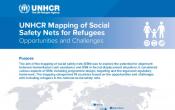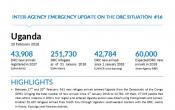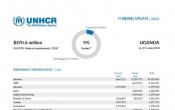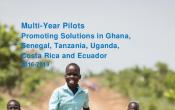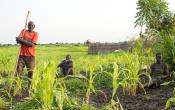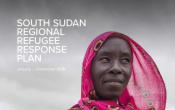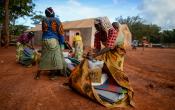Uganda
Operation: Uganda
Location
{"longitude":32,"latitude":1,"zoom_level":7,"iso_codes":"'UGA'"}
By clicking on the icons on the map, additional information is displayed.
Key Figures
| 2017 year-end results | |
| 265,620 | school-aged refugee children were enrolled in primary education |
| 187,450 | families received core-relief items |
| 134,590 | people were provided with land plots for housing and agricultural activities |
| 15,980 | refugees were provided with entrepreneurship or business training |
| 4,820 | SGBV survivors were provided with psychosocial counselling |
| 2,820 | individuals had cases submitted for resettlement, out of which 1,900 departed to resettlement countries |
| 2018 planning figures | |
| 1,000,000 | South Sudanese refugees will have access to permanent water solutions |
| 250,400 | refugee children will be enrolled in primary education |
| 12,400 | people will be provided with entrepreneurships/business support |
| 95% | of South Sudanese refugees will graduate from secondary education |
People of Concern
68%
Increase in
2016
2016
| 2016 | 1,162,715 |
| 2015 | 694,158 |
| 2014 | 600,989 |

[["Refugees",940835],["Asylum-seekers",41880],["Others of concern",180000]]
Loading ...
Uganda
< Back
2017
{"categories":[2013,2014,2015,2016,2017,2018],"budget":[114.34654277,232.15166991,221.407173083,302.144587466,551.108264853,470.58049854],"expenditure":[39.33546118,79.64090461,62.65819847,125.32271148,204.68911788,null]}
{"categories":[2013,2014,2015,2016,2017,2018],"p1":[102.66607349,228.48096459,218.337173083,302.036543216,550.908264853,470.38049854],"p2":[0.13792833,0.065,0.02,0.10804425,0.2,0.2],"p3":[11.54254095,3.60570532,3.05,null,null,null],"p4":[null,null,null,null,null,null]}
{"categories":[2013,2014,2015,2016,2017,2018],"p1":[39.30495899,79.64090461,62.65402181,125.31882094,204.67148964,null],"p2":[0.03050219,null,0.00417666,0.00389054,0.01762824,null],"p3":[null,null,null,null,null,null],"p4":[null,null,null,null,null,null]}
Loading ...
CHOOSE A YEAR
- 2014
- 2015
- 2016
- 2017
- 2018
Operational context
Throughout 2017, Uganda continued to receive refugees from Burundi, the Democratic Republic of Congo (DRC) and South Sudan. Despite the high number of South Sudanese continuing to arrive in 2017, Uganda welcomed and generously hosted forcibly displaced people from the region and maintained its open door policy. Within the Refugee Coordination Model, the Government of Uganda and UNHCR coordinated the response of some 100 partners operating in the country.The Government of Uganda provides a distinctly favourable protection environment for refugees characterized by a settlement approach. The Government of Uganda also continued to strengthen the refugee-hosting environment through the Settlement Transformative Agenda included in its five-year National Development Plan II (NDP II 2016-2020). The UN Country Team and World Bank were supporting the Government of Uganda through the Refugee and Host Population Empowerment (ReHoPE) strategy, which is integrated into the UN Development Assistance Framework for Uganda (UNDAF 2016-2020). These strategic initiatives are aligned with the Comprehensive Refugee Response Framework (CRRF) of the New York Declaration for Refugees and Migrants. Uganda was the first country to officially roll-out the CRRF in early 2017.
Population trends
At year end, the total population of refugees and asylum-seekers in Uganda was 1,395,000 people, with 986,600 people from South Sudan, some 236,400 from the DRC, and some 39,700 from Burundi. By the end of 2017, more than 58,200 people were pending biometric registration in the government registration system.In 2017, close to 403,780 refugees arrived in Uganda, mainly from South Sudan (354,560), and to a lesser degree the influx from the Democratic Republic of Congo (43,900 people) and from Burundi (5,310 people).
Even though the influx from the Democratic Republic of Congo remained low through the year, in December Uganda received some 6,240 new arrivals as a results of violence and tensions in various parts of the country.
Key Achievements
- The physical safety and security in reception and registration places were improved through the adequate presence of law enforcement bodies.
- UNHCR continued pursuing innovative solutions for sustainable socio-economic integration and integrated service delivery.
- UNHCR started the construction of shelters for people with specific needs, and of transit center facilities.
- Significant infrastructure improvements were made in the settlements, primarily in health and education.
- Refugees’ access to sustainable water supply systems was improved; as a result emergency water trucking was reduced to 23 per cent with plans in place for gradual phase-out in 2018. In total, 1,095,030 people had access to permanent water solutions.
- Projects benefiting host and displaced communities were implemented and resulted in improved relationships between UNHCR and local authorities and communities.
- All new arrivals from South Sudan were provided with shelter construction materials upon relocation from reception centres to their assigned plots.
Unmet needs
- The implementation of cash-based interventions was limited.
- Critical gaps in social service delivery persisted, and minimum standards were not met in the areas of education and health.
- The environmental protection activities, such as the promotion of energy-saving cooking stoves, and tree planting, were required to prevent environmental impacts.
- Challenges with UNHCR’s partner led to disruption of service delivery including life-saving activities and assistance to refugees living in urban settings.
- Due to funding challenges, the 2017 work plan and age gender diversity priorities from 2016 were not reviewed or adjusted to consistently implement 2017 activities. Consequently, this affected the accuracy of reporting for 2017. Thus most of the key indicators and performance targets at both impact and output level were not achieved.
- More than 23,800 separated children, 8,800 unaccompanied children; and 2,800 other children at risk continued to require targeted support.
Working environment
The year 2016 has seen a significant increase in the total population of concern to UNHCR in Uganda, largely as a result of the latest crisis in South Sudan. By October 2016, Uganda’s “open door” policy had enabled more than 600,000 refugees and asylum-seekers to access safety and protection. The majority of refugees in Uganda originate from Burundi, the Democratic Republic of the Congo and South Sudan and are granted prima facie recognition by the Government. With the support of UNHCR, the host community, various partners from the UN Country Team, civil society, and bilateral and multilateral development actors, the Government of Uganda ensures that refugees and registered asylum-seekers are protected, live in safety and dignity, and progressively attain lasting solutions.Uganda has established a protection-friendly environment that allows refugees to enjoy their rights and to rapidly resume and lead normal lives. The Uganda National Development Plan (NDP II 2015/16 - 2019/20) includes refugees in national development planning and structures through a Government strategy called the Settlement Transformative Agenda (STA).
Key priorities
To provide support to the Government of Uganda, the UN Country Team and the World Bank have jointly developed a framework for “Refugee and host population empowerment” (ReHoPE). This multi-year strategic framework supports coordinated and effective responses in the areas of: (i) emergency response, (ii) protection and integrated service delivery, (iii) sustainable and resilient livelihoods, and (iv) durable and development solutions for refugee and host communities. Resettlement continues to be an important element in protection and solutions strategies for refugees in Uganda, but is available for only a limited percentage of the refugee population.Potential funding shortfalls in 2017 could compromise the implementation of the multi-year strategic targets and outcomes identified by the Office. Lack of funding could also lead to losses in terms of operational effectiveness, political goodwill, and host community support.
